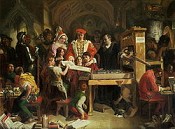Caxton William

William Caxton (c. 1415~1422 – c. March 1492) was an English merchant, diplomat, writer and printer. He was the first English person to work as a printer and the first person to introduce a printing press into England. He was also the first English retailer of books (his London contemporaries were all Dutch, German or French). William Caxton was the son of Philip and Dionisia Caxton. He had a brother named Philip. Caxton's date of birth is unknown, but records place it in the region of 1415–1424. He was born and educated in the Weald of Kent. Oral tradition in Hadlow claims that Caxton was born there; as does Tenterden. One of the manors of Hadlow was Caustons, owned by the Caxton family. A house in Hadlow reputed to be the birthplace of William Caxton was dismantled in 1936, and incorporated into a larger house rebuilt in Forest Row, Sussex.[1] Caxton went to London in the period 1437–1438, when he was between the ages of 14 and 17, to serve as an apprentice to Robert Large, a wealthy London mercer, or dealer in cloth, who served as Master of the Mercer's Company, and Lord Mayor of London in 1439. In 1446, he went to Bruges, where he was successful in business and became governor of the Company of Merchant Adventurers of London. His trade brought him into contact with Burgundy and it was thus that he became a member of the household of Margaret, Duchess of Burgundy, the sister of the English King. This led to more continental travel, including travel to Cologne, in the course of which he observed the new printing industry, and was significantly influenced by German printing. He wasted no time in setting up a printing press in Bruges in collaboration with a Fleming, Colard Mansion, on which the first book to be printed in English was produced in 1473: Recuyell of the Historyes of Troye,[2] a translation by Caxton himself. Bringing the knowledge back to his native land, he set up a press at Westminster in 1476 and the first book known to have been issued there was an edition of Chaucer's Canterbury Tales (Blake, 2004–7). Another early title was Dictes or Sayengis of the Philosophres (Sayings of the Philosophers), first printed on 18 November 1477, written by Earl Rivers, the king's brother-in-law. Caxton's translation of the Golden Legend, published in 1483, and The Book of the Knight in the Tower, published 1484, contain perhaps the earliest verses of the Bible to be printed in English. Caxton produced chivalric romances, classical-authored works and English and Roman histories. These books strongly appealed to English upper classes around the end of the fifteenth century. Caxton was supported by, but not dependent on, nobility and gentry. The most important works printed by Caxton were Dictes and Sayings of the Philosophers, Le Morte d'Arthur and Geoffrey Chaucer's Canterbury Tales. He produced two editions of the latter. Caxton's precise date of death is uncertain, but estimates from the records of his burial in St. Margaret's, Westminster, show that he died in about March 1492. Caxton was not without his detractors. There was widespread unease amongst the merchant class of the time, who felt that if the printed page were to become widely available to the population, then it might filter through to the poor. The poor, it was believed, might then "become aware and enlightened of their circumstances" and, ultimately, dissatisfied and aggrieved. This, it was felt, might lead to unrest and civil disturbance. In challenging the wisdom of his critics, Caxton announced: "If tis wrong I do, then tis a fine and noble wrong". Caxton printed four-fifths of his works in English. He translated a large amount of works into English. He translated and edited a large amount of the work himself. However, the English language was changing rapidly in Caxton's time and the works he was given to print were in a variety of styles and dialects. Caxton was a technician rather than a writer and he often faced dilemmas concerning language standardisation in the books he printed. (He wrote about this subject in the preface to his Eneydos.[3]) His successor Wynkyn de Worde faced similar problems. Caxton is credited with standardising the English language (that is, homogenising regional dialects) through printing. This facilitated the expansion of English vocabulary, the development of inflection and syntax and the ever-widening gap between the spoken and the written word. However, Richard Pynson, who started printing in London in 1491 or 1492 and who favoured Chancery Standard, was a more accomplished stylist and consequently pushed the English language further toward standardisation. It is asserted that the spelling ghost with the silent letter h was adopted by Caxton due to the influence of Dutch spelling habits. Billionaire Bruce Kovner named his firm Caxton Associates in honor of the printer.
do you like this author?
What readers are saying
What do you think? Write your own comment on this book!
write a commentWhat readers are saying
What do you think? Write your own comment on this author!
write a commentBook list

Dialogues in French and English
Series:
Unknown
Year:
Unknown
Raiting:
3/5
The work now for the first time reprinted from Caxton's original edition has been preserved in three copies. One of these is in the Library of Ripon Cathedral, another in the Spencer Library, now at Manchester, and the third at Bamborough Castle. A small fragment, consisting of pp. 17-18 and 27-28, is in the Bodleian Library. The text of the present edition is taken from the Ripon copy. I have not had an opportunity of seeing this myself; but a type-written transcript was supplied to me by Mr. John Whitham, Chapter Clerk of Eipon Cathedral, and the proofs were collated with the Ripon book by the Rev. Dr. Fowler, Vice-Principal of Bishop Hatfield's Hall, Durham, who was kind enough to reexamine every passage in which I suspected a possible inaccuracy. It is therefore reasonable to hope that the present reprint will be found to be a strictly faithful representation of the original edition.The earlier bibliographers gave to the book the entirely inappropriate title of ' Instructions About the Publisher Forgotten Books is a publisher of historical writings, such as: Philosophy, Classics, Science, Religion, History, Folklore and Mythology.Forgotten Books' Classic Reprint Series utilizes the latest technology to regenerate facsimiles of historically important writings. Careful attention has been made to accurately preserve the original format of each page whilst digitally enhancing the difficult to read text. Read books online for free at www.forgottenbooks.org
Show more
add to favoritesadd In favorites

Game and Playe of the Chesse
Series:
Unknown
Year:
Unknown
Raiting:
3.5/5
According to Mr. William Blades, our latest and best authority on the subject, there are but ten copies known of the first edition of the “Chesse” book.2
Show more
add to favoritesadd In favorites
Book list

Dialogues in French and English
Series:
Unknown
Year:
Unknown
Raiting:
3/5
The work now for the first time reprinted from Caxton's original edition has been preserved in three copies. One of these is in the Library of Ripon Cathedral, another in the Spencer Library, now at Manchester, and the third at Bamborough Castle. A small fragment, consisting of pp. 17-18 and 27-28, is in the Bodleian Library. The text of the present edition is taken from the Ripon copy. I have not had an opportunity of seeing this myself; but a type-written transcript was supplied to me by Mr. John Whitham, Chapter Clerk of Eipon Cathedral, and the proofs were collated with the Ripon book by the Rev. Dr. Fowler, Vice-Principal of Bishop Hatfield's Hall, Durham, who was kind enough to reexamine every passage in which I suspected a possible inaccuracy. It is therefore reasonable to hope that the present reprint will be found to be a strictly faithful representation of the original edition.The earlier bibliographers gave to the book the entirely inappropriate title of ' Instructions About the Publisher Forgotten Books is a publisher of historical writings, such as: Philosophy, Classics, Science, Religion, History, Folklore and Mythology.Forgotten Books' Classic Reprint Series utilizes the latest technology to regenerate facsimiles of historically important writings. Careful attention has been made to accurately preserve the original format of each page whilst digitally enhancing the difficult to read text. Read books online for free at www.forgottenbooks.org
Show more
add to favoritesadd In favorites

Game and Playe of the Chesse
Series:
Unknown
Year:
Unknown
Raiting:
3.5/5
According to Mr. William Blades, our latest and best authority on the subject, there are but ten copies known of the first edition of the “Chesse” book.2
Show more
add to favoritesadd In favorites
What readers are saying
What do you think? Write your own comment on this author!
write a commentif you like Caxton William try:
readers also enjoyed
What readers are saying
What do you think? Write your own comment on this author!
write a commentif you like Caxton William try:
readers also enjoyed
Do you want to exchange books? It’s EASY!
Get registered and find other users who want to give their favourite books to good hands!

